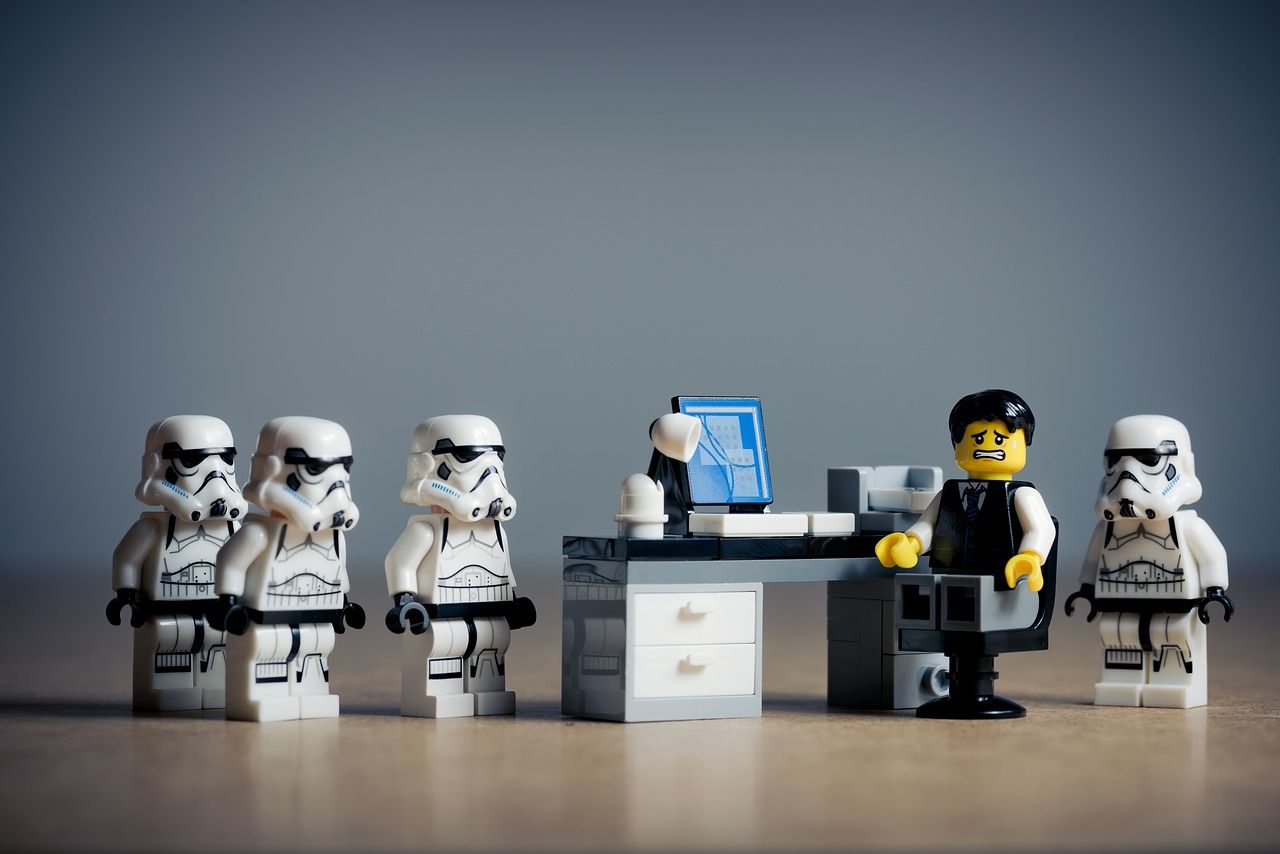Organizational conflict goes hand in hand with leadership. Being a leader is like practicing a contact sport like rugby. It requires the players to solve their problems so that the game can continue without any problems. On the pitch, fouls and injuries are inevitable, just like conflicts in the workplace - sooner or later they will arise in any organization. Therefore, what businesses need is the ability to recognize conflict, understand its nature, and find a quick and fair solution.
- Conflict in the organization - the most common causes
- Conflict in organization - a case study
- Consequences of an unresolved conflict
- Conflict in the organization - an example of a company from the financial industry
- Effective ways of dealing with conflict in the organization
- How to avoid a conflict in the organization?
- How can we learn from the conflict?
Organizational conflict rarely resolves itself - in fact, it tends to worsen if it is not dealt with properly and proactively. It is not uncommon for something that may have been resolved at an early stage to turn into a monumental problem because it has not been addressed at an early stage. Though conflict is a normal part of any social and organizational environment, the challenge is to how we will deal with it. Hidden, avoided or otherwise ignored, it will most likely aggravate it and turn into resentment. It will also cause mutual grievances to grow. A further escalation of the conflict may lead to the departure of employees and the emergence of a situation where the only option is to enter the - crisis management.
Do you think that the conflict in the company is the end of the world?
You can manage it effectively.
Conflict in the organization - the most common causes
What leads to conflicts in the workplace? There can be many reasons for this. From having a different opinion, through the tensions of competing for position, to fighting for power. The flash point may well be an offended ego, pride, jealousy, or discrepancies in the results achieved. For someone, the reason to go into conflict may be problems with wages, and someone just has a bad day, so they start to provoke arguments by their behavior. Although, following this list, you might think that almost anything could be the beginning of a crisis, in fact most conflicts is due to two reasons. Organizational conflict usually arises either from poor communication or from being unable to control your emotions.
Remember the conflicts you have encountered so far in the workplace. You will quickly discover that many of them were due to a lack of information, insufficient information, misinformation or misinformation. Suppose you were lucky and received good information, but did not know what to do with it ... It still is communication problem, which can lead to a conflict. That is why well-planned is so important communication strategy, also the internal one. Clear, concise, accurate and timely communication of information helps mitigate both the number and severity of conflicts.
Another common misconception in the workplace that leads to conflict is letting emotions influence the decisions you make. It is our human condition that passes by no one. Even directors sometimes put the need for emotional superiority over the implementation of assumptions. It is human nature that emotions prevail and will always lead to "thinking gaps". No matter how much we all wish it wasn't, it is. So it remains to find an answer to the question of what to do when a conflict in the organization begins to grow and how to deal with it effectively.

Conflict in organization - a case study
No two people are alike, and when different motivations, processes, and goals collide, conflicts arise. Conflict in the organization, however, it is not always something to be feared for because it results in change. Correctly resolved conflicts can lead to better ideas, better understanding and better relationships at work. Thanks to thoughtful resolution of conflicts in the workplace, both companies and their employees can develop. Let's analyze what types of conflicts occur most often in companies and what to do to avoid them.
1. Conflicts arising from interdependence
These kinds of misunderstandings arise when people in a network of interdependent projects need to coordinate their tasks so that everyone can successfully do their part of the work. For example, an accountant cannot do his job without all the data. If another employee is consistently late with his reports, it affects the accountant's ability to complete the job and meet deadlines. Solution? Effective delegation of tasks. The team should be informed who is responsible for what and what is accountable for. If everyone knows what to do exactly as part of their duties, then everyone feels like a teamwhose members play together to the same goal.
2. Leadership conflicts
Everyone has a different style of leadership and each employee reacts to it differently. Some leaders are courageous and charismatic, others are more laid-back, warm, and encouraging. Some are highly "technical" and have a strict adherence to rules and deadlines. Others, on the other hand, leave their employees so free that they are almost invisible in the corporate corridor. In order to resolve a potential conflict in an organization, emphasis should be placed on mutual respect for differences across the company. Leaders should be aware of their own leadership styles and how they interact with the work styles and personalities of those on their team. They should be able to adapt to their employees and be able to cooperate with them regardless of their own leadership preferences.
3. Conflicts caused by different styles of work
Just as there are different styles of leadership, there are also different styles of work. Some people prefer to work in groups, while others work best alone. Some people don't need extra guidance to get a job done, others like to be prompted and prompted at every step. Some people do more work under pressure, while others like to get what they have to do right away. How to reconcile it? The same principle applies as with any interaction with people - mutual respect and understanding. We may prefer a certain style of work, but sometimes teams have to work together in groupsto come up with a better idea than one person could think of. This means that in order to work out the best solutions, employees must learn to work together, regardless of their differences.
4. Personal conflicts
We are all different and we will not always like everyone we meet. Yes, it is not easy to work with someone who, for various reasons, is not to our liking. It's important to remember that how we perceive someone does not necessarily mean that they really are. Conflict in organisation could often be solved, and even avoid it, thanks to empathy and understanding. Imagine this situation. You are in a traffic jam on the freeway and suddenly the car in front of you starts making dangerous maneuvers, trying to turn around. You'll probably think he's the cheeky type and mindless dodger. What if he's just taking his wife in labor to the hospital? This changes things a bit, I guess. Only we ultimately know the rationale behind our actions. So don't let what you see define everything you will think of that someone in the future.
5. Conflicts related to the implementation of ideas
Brainstorming is a great opportunity to share your best ideas. Employees can then get to know others' ideas, express their own, and then use the best elements of each to arrive at a great solution. If two people do not agree as for the project idea, they should first talk to yourself and decide together about the implementation of one or the other. They can also seek a compromiseto bring both ideas together for even better collaboration results. If necessary, they can also ask another colleague or supervisor to mediate in the discussion or to provide their opinion on the final decision.
Consequences of an unresolved conflict
Leaving an unresolved conflict can cause serious problems for employee morale and productivity. Organizational conflict is also detrimental to the company's culture. Nobody wants to work in a tense, passive-aggressive environment where they are constantly uncomfortable. When people don't like their workplace, there is more staff turnover, more sick leave and poorer productivity.

Conflict in the organization - an example of a company from the financial industry
Let's analyze the process of getting out of a conflict in a financial industry company step by step. Two key managers has long been involved in conflict. The CEO for some time tried to react on an ongoing basis to comments made by each of them about the other. It seemed to be internal communication works in the company without any reservations. But the situation worsened. The director noticed the growing tension and discomfort caused by the situation for both managers. Moreover, their problems affected other members of the team as well. The help of a facilitator turned out to be necessary, i.e. someone who takes an active part in facilitating the process of communication between people or groups, in order to reach a common solution.
During individual meetings with each manager and CEO, work was done to determine the best solution. Each party received help in identifying and expressing your own concerns and how they perceived the problems causing the conflict. They also all identified the results they would like to achieve in this process. It prevailed between all participants in the conflict - despite serious difficulties and growing tensions goodwill and mutual respect. Later, the meetings were held with the participation of the entire group - both managers and the CEO, who worked closely with his subordinates. The roles of these three were related to each other, which required that they all agreed in their expectations and relationships at work. Further conflict within the organization would be of no use to anyone.
Thanks to the meetings, the parties were able to learn about concerns from all three perspectives. It was an opportunity to explain and discuss the perceptions as well as the different behaviors and styles of action. All parties felt heard by others and were able to focus on solving problemseven though sometimes emotions tried to come to the fore. Ultimately, a set of Mutually Agreed Actions was implemented. This involved changes that each side agreed to accept in the name of higher values.

Ultimately, it turned out that the conflict in the organization began with the uncertainty surrounding the role played in the company. This is what turned out key element of the conflict. To resolve the situation, it was necessary to clarify the expectations of all parties. Roles, responsibilities and interdependence were re-examined. The stress level of managers and director has been significantly lowered. Everyone, too, was relieved to work through the problems and reach a common win-win solution.
Effective ways of dealing with conflict in the organization
As a rule, the essence of the conflict lies in improper communication. Properly formulated information may stimulate the development of conflict situations or effectively extinguish them. By controlling communication, we control emerging conflicts. Organizational conflicts are a natural and inevitable phenomenon. And while they don't always have negative consequences, it's worth learning how to keep them in check. Disputes between employees can increase their productivity, commitment and effort put into carrying out daily tasks, but if not skilfully moderated, they start to lead to unhealthy and destructive competition.
The most desirable way to deal with a conflict is to reach a compromise between the parties involved in the dispute. Thanks to this, we can ensure the benefit of each party, and at the same time show that in addition to private interest, there is also the good of the entire organization, which should also be taken care of. Unfortunately, we are not able to resolve all conflicts by compromise. Sometimes neither party has an idea of how to resolve a conflict situation and nobody wants to change their attitude towards the issue in dispute. Then it is worth using the help of impartial mediators and external experts.
Methods of solving problems in the organization are different. One of the tools used to analyze the causes and sources of conflict is the so-called the conflict wheel, thanks to which we can check whether the conflict occurs at the level of data, relationships, values, structure or specific interests. The mediator's task is to create a platform for agreement for the parties at issue, and not to clearly indicate who is right. Providing such a platform for free expression of opinions will prevent problems from being swept under the rug, but if properly worked through, they will lead to changes that help build an even more efficient organization.

How to avoid a conflict in the organization?
Knowledge, knowledge and one more time knowledge! Crises arise from the uncertainty and chaos of information, so it is very important to know the needs of individual employees. Proper work organization, based on the use of the strengths and capabilities of employees and effective communication between them, significantly affect the comfort of work of the entire team. For this purpose, it is necessary to take care of both the proper flow of information between employees, as well as enable them to integrate, leading to building bonds and a sense of loyalty to others and to the organization they represent.
In order not to arouse conflicts within the organization, transparent procedures and work standards for individual positions should be introduced. Perfect organizational structures do not exist. Success lies in clearly defining the rights and obligations arising from each position held. The employee appraisal and remuneration system must be clear and fair enough, on the one hand, to adequately motivate people to work, and on the other hand, not to lead to the reign of unhealthy competition. Crises arise most often from differences in the understanding of the scope of one's duties or the manner of performing specific tasks, as well as from an unfair or unclear system of remuneration and rewards.

In order to avoid potential conflicts in the organization, it is important to get to know the people who make up the team of employees of a given organization. Their individual characteristics and strengths and weaknesses, as well as the interactions they engage in with other employees, may be more or less conflict-generating. Differences that result from character, status, culture and power, can perfectly complement each other or create a truly explosive mixture. Nevertheless, it is always worth having a plan B - developed crisis management process it will make it possible to implement appropriate actions, preventing the conflict from escalating.
How can we learn from the conflict?
Every business will have employees who don't get along from time to time. Whether it's due to differences in their personalities, lifestyles, opinions, or some other factor. It just happens. And when there is disagreement in the workplace, it affects everyone. The resulting tension not only creates a thick atmosphere in the office. Conflict in the organization can also negatively affect the company's productivity. Therefore, it is impossible to stand with folded arms. You have to act, look for solutions and positive sides of this situation. Conflict "overworked" in a constructive way can, as a result, bring a lot of good - incl. streamline processes, implement innovations and increase creativity.

